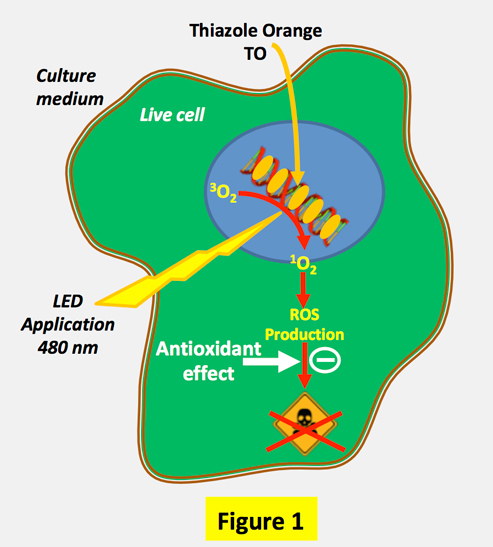LUCS technology
The AOP approach is based on a unique technology which measures antioxidant effects on live cells. This technology called LUCS (for Light Up Cell System) originates in a fluorescence assay whose intimate mechanisms were deciphered at the intracellular level in the recent years (2015-2017).
LUCS technology uses the variations of fluorescence intensity of a live cell nuclear biosensor belonging to the asymmetric cyanine family of compounds (thiazole orange, TO) to establish the cell homeostasis status. LUCS process was standardized on 96-well culture plates and is available for any cell model (containing DNA) and for any sample type (pure substances, extracts, finished products, …) Experimental studies showed for the first time that generation of oxidative stress can be tightly controlled within the cells through the photoactivation of the cell biosensor using a simple application of light intensity. This research led to a major discovery which was published by the AOP team in the international journal Nature (on-line version, Scientific Reports), on December 22nd 2017 (ref : https://www.nature.com/articles/s41598-017-18211-2.pdf).
LUCS test method principle
The experimental procedure is simple. The TO biosensor is added to the cell culture medium and becomes fluorescent after association with the cell nucleic acids. When TO is photoactivated by LED illumination at 480 nm, it’s relaxation is accompanied by an energy transfer to the intracellular dioxygen molecule (3O2) resulting in the production of singlet oxygen (1O2) and a cascade of Reactive Oxygen Species (ROS) production including superoxide anion (O2.-) and hydroxyl radical (OH.) (see fig. 1). The antioxidant effect of a substance can then be measured by its ability to counteract this intracellular ROS production.

Dose-Effect curves
Intracellular antioxidant effect is revealed by a time delay in the fluorescence increase triggered by the LED-dependent photo-activation of TO. Figure 2 illustrates the fluorescence profiles of human HepG2 cells treated 4 h at different resveratrol concentrations. Resveratrol is a powerful cellular antioxidant that is known for being active both as a ROS scavenger and as an inducer of the cell natural defense driven by Nrf2 pathway. Control (non-treated) curve is illustrated in black. Differences between control and sample Area Under Curves (AUC) allow to establishing an index (AOP index) that qualify the intracellular antioxidant effect of the sample.

EC50s and other parameters revealing antioxidant effects
Calculation of LUCS index at different sample concentrations allows to establish dose-effect profiles that fits well with sigmoid regression, allowing the evaluation of the EC10 (Efficacy Concentration 10%, threshold of cellular effect), the standard EC50 (Efficacy Concentration 50%) and the EC90 (Efficacy Concentration 90%, weakest dose at which the compound acts with a maximum effect). Figure 3 illustrates an example of dose-effect curves obtained after treatment with resveratrol for 1 and 4 h on human HepG2 cells.

LUCS : a multifaceted test method
More generally, LUCS fluorescence profiles provide information on several parameters that are specific to the tested sample and the chosen cell model. In addition to the antioxidant effect described above, LUCS test highlights pro-oxidant effects (left-shift of the sample profile) and cytotoxic effects (initial fluorescence is high and illumination remains non effective) (Figure 4), bringing added value to the method. It is also noteworthy that the LUCS technology works on any kind of eukaryotic (animal, vegetal, fungal) and prokaryotic (bacteria) cell models.



